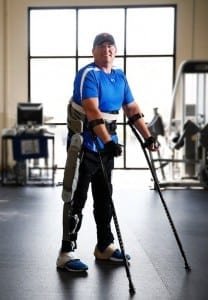
The dream of regaining the ability to stand up and walk has come closer to reality for people paralyzed below the waist who thought they would never take another step.
A team of engineers at Vanderbilt University’s Center for Intelligent Mechatronics has developed a powered exoskeleton that enables people with severe spinal cord injuries to stand, walk, sit and climb stairs. Its light weight, compact size and modular design promise to provide users with an unprecedented degree of independence.
The university has several patents pending on the design and Parker Hannifin Corporation – a global leader in motion and control technologies – has signed an exclusive licensing agreement to develop a commercial version of the device, which it plans on introducing in 2014.
According to the National Spinal Cord Injury Statistical Center, somewhere between 236,000 to 327,000 people in the U.S. are living with serious spinal cord injuries. About 155,000 have paraplegia. The average age at injury is 41 and the estimated lifetime cost when it happens to a person of 50 ranges from $1.1 million to $2.5 million.
Until recently “wearable robots” were the stuff of science fiction. In the last 10 years, however, advances in robotics, microelectronics, battery and electric motor technologies advanced to the point where it has become practical to develop exoskeletons to aid people with disabilities. In fact, two companies – Argo Medical Technologies Ltd. in Israel and Ekso Bionics in Berkeley, Calif. – have developed products of this type and are marketing them in the U.S.
These devices act like an external skeleton. They strap in tightly around the torso. Rigid supports are strapped to the legs and extend from the hip to the knee and from the knee to the foot. The hip and knee joints are driven by computer-controlled electric motors powered by advanced batteries. Patients use the powered apparatus with walkers or forearm crutches to maintain their balance.
“You can think of our exoskeleton as a Segway with legs,” said Michael Goldfarb, the H. Fort Flowers Chair in Mechanical Engineering and professor of physical medicine and rehabilitation. “If the person wearing it leans forward, he moves forward. If he leans back and holds that position for a few seconds, he sits down. When he is sitting down, if he leans forward and holds that position for a few seconds, then he stands up.”
Goldfarb developed the system with funding from the National Institutes of Health and with the assistance of research engineer Don Truex, graduate students Hugo Quintero, Spencer Murray and Kevin Ha, and Ryan Farris, a former student who now works for Parker Hannifin.
“My kids have started calling me ‘Ironman,’” said Brian Shaffer, who was completely paralyzed from the waist down in an automobile accident on Christmas night 2010. He has been testing the Vanderbilt apparatus at the Nashville-area satellite facility of the Shepherd Center. Based in Atlanta, Shepherd Center is one the leading hospitals for spinal cord and brain injury rehabilitation in the U.S. and has provided the Vanderbilt engineers with the clinical feedback they need to develop the device.
“It’s unbelievable to stand up again. It takes concentration to use it at first but, once you catch on, it’s not that hard: The device does all the work. I don’t expect that it will completely replace the wheelchair, but there are some situations, like walking your daughter down the aisle at her wedding or sitting in the bleachers watching your son play football, where it will be priceless,” said Shaffer, who has two sons and two daughters.
The Latest Streaming News: Exoskeleton updated minute-by-minute
Bookmark this page and come back often
Latest NEWS
Latest VIDEO







